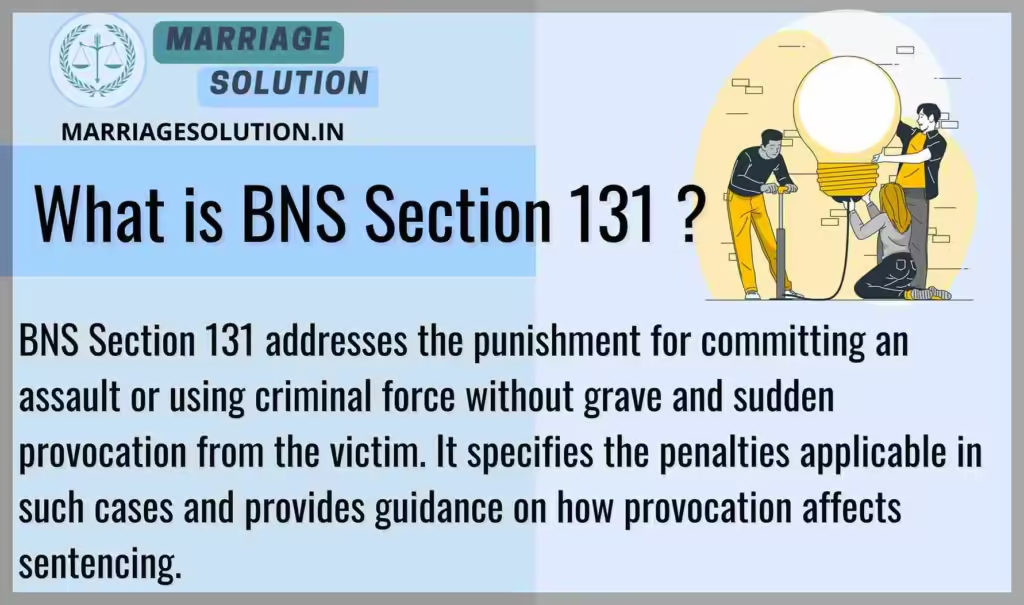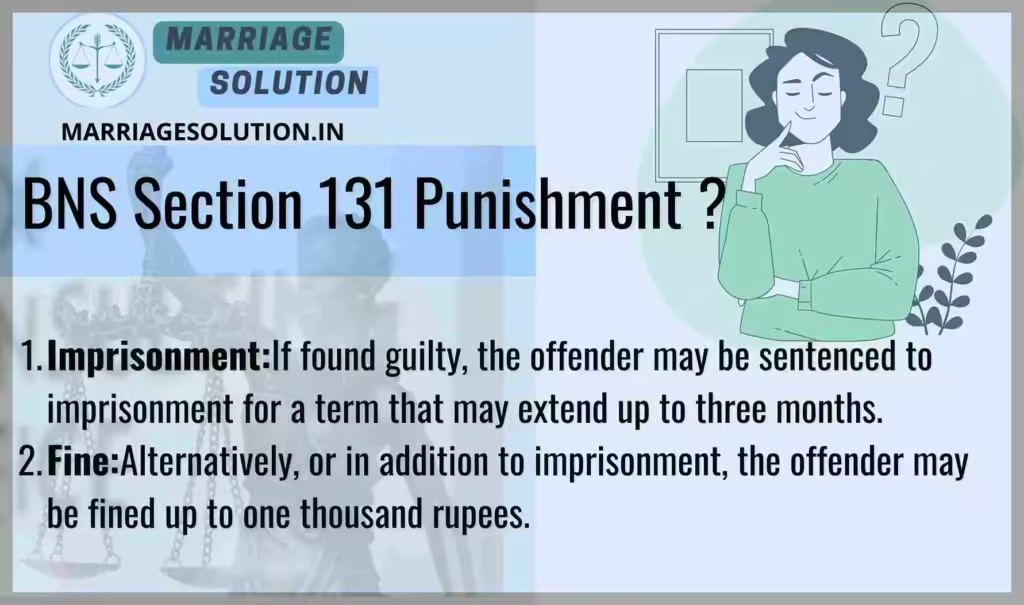Introduction of Section 131 BNS
BNS Section 131 deals with the punishment for assault or use of criminal force when there is no grave and sudden provocation from the victim. It ensures that people cannot justify violence by citing trivial or intentional provocations. The section also clarifies that lawful acts by public servants or acts of private defense cannot be treated as valid provocations. This law plays a crucial role in holding individuals accountable for unprovoked aggression, while balancing fairness when genuine provocation exists.
The Bharatiya Nyaya Sanhita (BNS) Section 131 replaces the old Indian Penal Code (IPC) Section 352.
What is section 131 of BNS ?
BNS Section 131 addresses the punishment for committing an assault or using criminal force without grave and sudden provocation from the victim. It specifies the penalties applicable in such cases and provides guidance on how provocation affects sentencing.

Under Section 131 of the bns act 2023
Whoever assaults or uses criminal force to any person, otherwise than on grave and sudden provocation given by that person, shall be punished with simple imprisonment for a term which may extend to three months, or with fine which may extend to one thousand rupees, or with both.
Provocation is not considered valid if—
- The offender sought the provocation intentionally, or
- The provocation was given by a public servant in lawful exercise of duty, or
- The provocation came from an act done in lawful exercise of private defense.
Section 131 punishes assault or criminal force when there is no serious and sudden provocation from the victim.
- If a person attacks someone without being provoked, they can face up to 3 months’ jail or ₹1,000 fine, or both.
- If provocation is claimed, it must be serious and sudden—not something minor, intentional, or lawful.
- Actions by police officers, or someone defending themselves, cannot be treated as provocation to excuse the offender.
Key Elements of Section 131
- Assault or Force → Must be voluntary use of force or threat of force.
- No Grave & Sudden Provocation → If the victim did not seriously provoke the offender, this section applies.
- Exceptions → Provocation isn’t valid if it was:
- Intentionally invited by the offender,
- From lawful acts of public servants,
- From lawful private defense.
- Punishment → Up to 3 months imprisonment or ₹1,000 fine, or both.
- Classification → Non-cognizable, bailable, compoundable, triable by any Magistrate.
Examples to Understand Section 131
- Example 1 (Street Argument):
A lightly insults B in conversation. B, without any grave provocation, slaps A.
Section 131 applies → Punishable with up to 3 months jail or fine. - Example 2 (Lawful Officer):
A police officer lawfully stops X for reckless driving. X pushes the officer claiming he was “provoked.”
Not valid provocation → Section 131 applies → Jail or fine.
Why Section 131 is Important
- Prevents misuse of “provocation” as an excuse for assault.
- Protects public servants and people acting in self-defense.
- Ensures that minor insults or lawful acts cannot reduce punishment.
- Promotes accountability for unprovoked violence.
Section 131 BNS Overview
BNS Section 131 defines the punishment for individuals who assault or use criminal force against another person, except when the action is provoked by grave and sudden provocation from the victim. It outlines the conditions under which such provocation will or will not influence the severity of the penalty.
Section 131 BNS Overview: 10 Key Points in Very Simple Words
- Assault and Force:
This section addresses situations where a person commits assault or uses force without serious provocation from the other person. - Scope of Provocation:
Provocation needs to be both grave (serious) and sudden for it to affect the severity of the punishment. If the provocation was intentional or related to lawful actions, it does not lessen the penalty. - Punishment Options:
The law provides for imprisonment of up to three months, a fine of up to one thousand rupees, or both as punishment for this offense. - Classification:
The offense is non-cognizable, meaning that the police cannot arrest the offender without a warrant, and investigations require magistrate approval. - Bail Status:
The offense is bailable, allowing the accused to be released on bail. - Compounding of Offense:
It is compoundable, which means that the complainant and accused can settle the case with the magistrate’s permission. - Exceptions to Provocation:
Provocation will not reduce the punishment if it was sought by the offender, was a result of lawful actions by a public servant, or was part of self-defense. - Role of the Magistrate:
The case can be tried by any magistrate, and they have the authority to decide on the bail and compounding of the offense. - Fact Determination:
Whether the provocation was grave and sudden enough to mitigate the punishment is determined based on the facts of the case. - Legal Framework:
This section aims to ensure that the punishment for assault or force is proportionate to the circumstances, especially when provocation is not a valid excuse.
Examples
- Example 1: Street Altercation
- Scenario: John and Mike get into an argument on the street. In a fit of anger, John shoves Mike without any serious provocation from Mike. John is arrested under Section 131.
- Explanation: Since Mike did not provoke John in a serious or immediate manner, and John’s actions were not justified or lawfully excused, John is punishable under Section 131. The lack of serious provocation means John faces potential imprisonment for up to three months, a fine, or both.
- Example 2: Unprovoked Physical Contact
- Scenario: Sarah, a store manager, uses physical force to remove a customer who was acting unruly. The customer did not provoke Sarah in a serious or sudden way, and the removal was not in response to a legal requirement.
- Explanation: Sarah’s use of force, not provoked by a serious or sudden incident, falls under Section 131. The law considers that Sarah’s actions were not justified by any grave provocation. Thus, Sarah could face imprisonment, a fine, or both as per the section’s stipulations.
Section 131 BNS punishment
- Imprisonment:
If found guilty, the offender may be sentenced to imprisonment for a term that may extend up to three months. - Fine:
Alternatively, or in addition to imprisonment, the offender may be fined up to one thousand rupees.

BNS 131 bailable or not ?
Yes, BNS Section 131 is bailable. This means that if someone is charged under this section, they have the right to be released on bail while awaiting trial.
Comparison Table – BNS Section 131 vs IPC Section 352
| Section | Offence | Punishment | Bailable / Non-Bailable | Cognizable / Non-Cognizable | Trial By |
|---|---|---|---|---|---|
| BNS Section 130 | Assault — when a person intentionally causes another to apprehend that force will be used against them. It involves the threat of physical harm without actual contact. | Simple imprisonment up to 3 months, or fine up to ₹1,000, or both. | Bailable | Non-Cognizable | Any Magistrate |
| IPC Section 351 (Old) | Assault — intentionally making any gesture or preparation causing another to apprehend the use of criminal force, without actual contact. | Punishable with imprisonment up to 3 months, or fine up to ₹500, or both. | Bailable | Non-Cognizable | Any Magistrate |
BNS Section 131 FAQs
What is BNS Section 131 about?
BNS Section 131 deals with the punishment for assault or criminal force when committed without grave and sudden provocation.
What are the possible punishments under Section 131?
The possible punishments include imprisonment for up to three months, a fine up to one thousand rupees, or both.
Is the offense under Section 131 cognizable?
No, it is classified as non-cognizable, meaning the police cannot arrest the accused without a warrant.
Can the offense under Section 131 be settled outside of court?
Yes, it is a compoundable offense, allowing for settlement with the complainant’s consent and magistrate approval.
What factors are considered to mitigate the punishment under Section 131?
Grave and sudden provocation may mitigate the punishment, but it will not apply if the provocation was sought by the offender or was part of lawful actions.
Conclusion
BNS Section 131 ensures that unprovoked assault or criminal force does not go unpunished. By setting out clear punishments and exceptions, the law prevents offenders from hiding behind excuses of trivial provocation. At the same time, it safeguards public servants and individuals acting lawfully from being wrongly blamed for “provoking” violence. This section, which corresponds to IPC Section 352, reflects India’s ongoing effort to create a balanced legal framework that punishes unprovoked aggression while recognizing genuine provocation in rare cases.
Need Legal Support?
If you’re facing court proceedings, marriage-related issues, or any legal matter, our team at Marriage Solution – Lawyer Help is ready to guide you. Just complete our easy online enquiry form, and we’ll connect you with the right legal assistance tailored to your needs.
Finished with BNS 131 ? Continue exploring the next provisions of the Bharatiya Nyaya Sanhita (BNS), 2023. Each section includes explanations, examples, and plain-language breakdowns for easy understanding.
- 132 BNS : Assault or criminal force to deter public servant from discharge of his duty .
- https://marriagesolution.in/bns_section/132-bns/
- 133 BNS : Assault or criminal force with intent to dishonor person, otherwise than on grave provocation.
- https://marriagesolution.in/bns_section/133-bns/
- BNS 134 : Assault or criminal force in attempt to commit theft of property carried by a person.
- https://marriagesolution.in/bns_section/bns-134/
- BNS Section 135 : Assault or criminal force in attempt wrongfully to confine a person.
- https://marriagesolution.in/bns_section/bns-section-135/
- BNS 136 : Assault or criminal force on grave provocation.
- https://marriagesolution.in/bns_section/bns-136/
Full IPC Section List: https://marriagesolution.in/ipc-section-list
All Indian Law & Blogs: https://marriagesolution.in/indian-law/
Full BNSS Section List: https://marriagesolution.in/bnss_section-list
